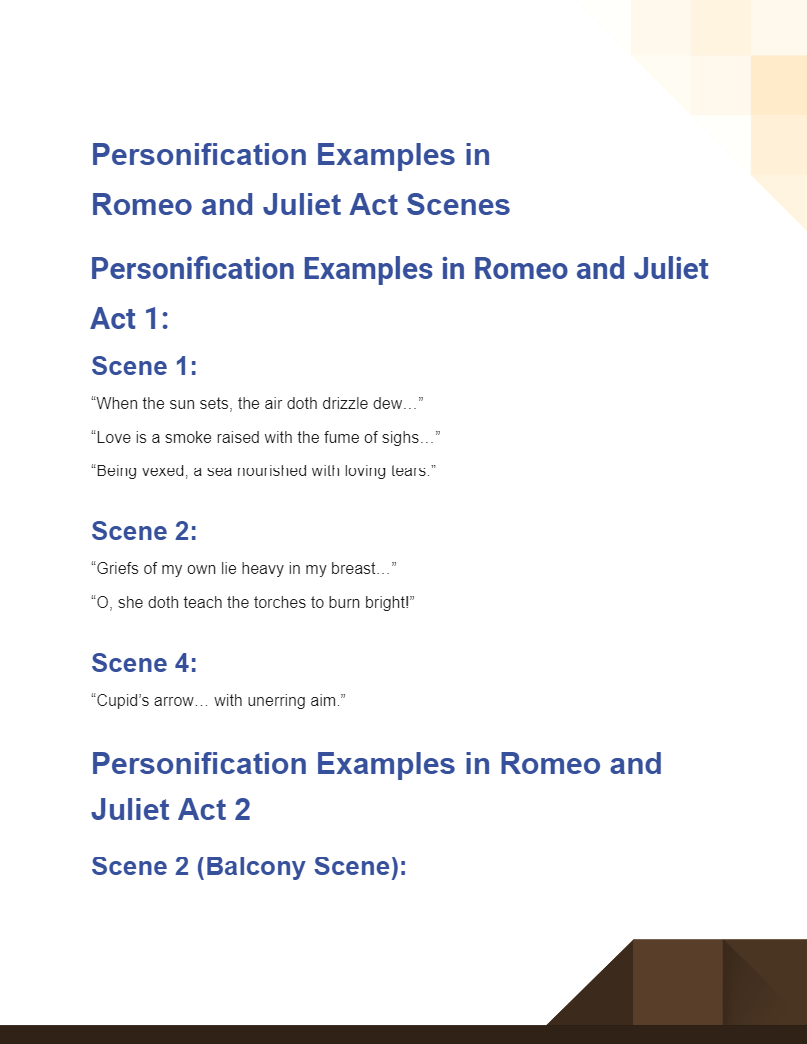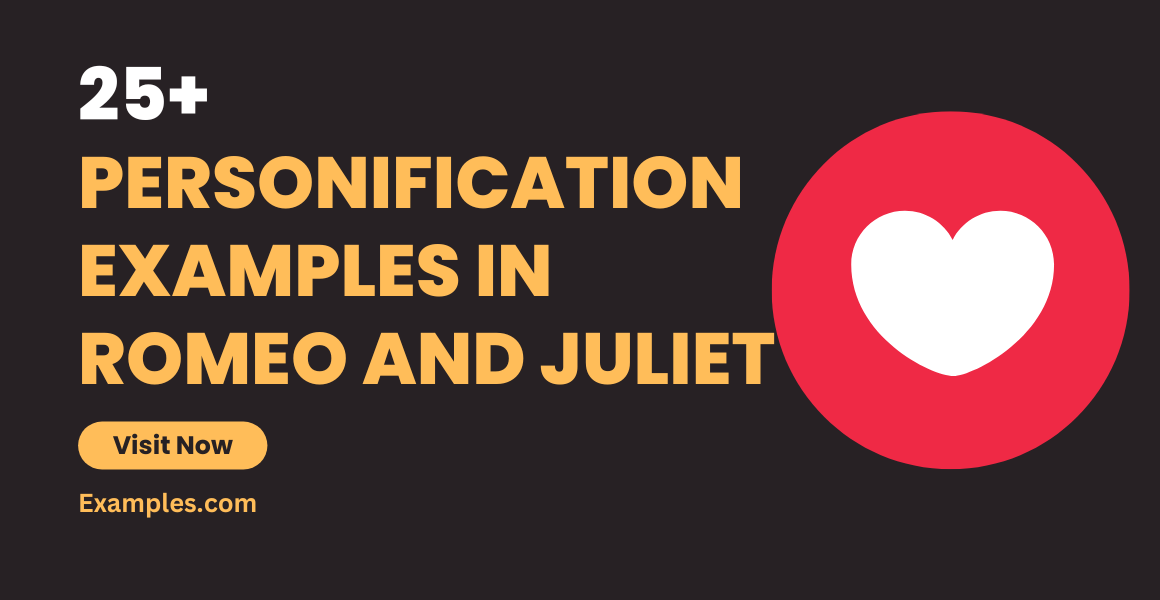Personification in Romeo and Juliet
Shakespeare’s timeless classic, ‘Romeo and Juliet’, offers more than just a tragic tale of star-crossed lovers. Delving deeper, one finds the Bard’s ingenious use of personification, breathing life into inanimate objects, making them as expressive as the protagonists themselves. As we explore these evocative personification examples, let’s also uncover how to craft such vivid imagery in our own writing, learning from the master himself. Dive in for a poetic journey interspersed with invaluable writing tips!
Personification in “Romeo and Juliet” – Definition
Personification is a literary device where non-human objects or abstract concepts are given human qualities or characteristics. In “Romeo and Juliet,” Shakespeare frequently uses personification to add depth, emotion, and vividness to his descriptions, making the setting and situations even more evocative for the readers or audience.
Example of Personification in the Prologue of “Romeo and Juliet”
In the Prologue of “Romeo and Juliet,” the Chorus says:
“From forth the fatal loins of these two foes A pair of star-cross’d lovers take their life.”
Here, the term “star-cross’d” is a form of personification. Stars, of course, do not have the human ability to cross or make decisions, but this expression gives them a human-like quality of controlling or influencing fate. The idea is that the stars (or fate) are against the love of Romeo and Juliet, suggesting that their tragic end was predetermined by the heavens.
Famous Personifications in Romeo and Juliet

In “Romeo and Juliet”, Shakespeare’s use of personification transforms abstract concepts into vivid imagery, giving life to inanimate objects and intangible emotions, enhancing the emotional depth and setting of the play.
Personification Examples in Romeo and Juliet Act 1:
Scene 1:
“When the sun sets, the air doth drizzle dew…”
“Love is a smoke raised with the fume of sighs…”
“Being vexed, a sea nourished with loving tears.”
Scene 2:
“Griefs of mine own lie heavy in my breast…”
“O, she doth teach the torches to burn bright!”
Scene 4:
“Cupid’s arrow… with unerring aim.”
Personification Examples in Romeo and Juliet Act 2
Scene 2 (Balcony Scene):
“Arise, fair sun, and kill the envious moon…”
“The brightness of her cheek would shame those stars…”
“Her eyes in heaven would through the airy region stream so bright.”
Scene 3:
“The grey-eyed morn smiles on the frowning night…”
“Earth that’s nature’s mother is her tomb.”
Scene 6:
“These violent delights have violent ends.”
Personification Examples in Romeo and Juliet Act 3
Scene 2:
“Gallop apace, you fiery-footed steeds…”
“Come, night; come, Romeo…”
“Lovers can see to do their amorous rites by their own beauties.”
Scene 5:
“Night’s candles are burnt out…”
“Jocund day stands tiptoe on the misty mountain tops.”
Personification Examples in Romeo and Juliet Act 4
Scene 3:
“My dismal scene I needs must act alone.”
“The vaulty heaven so high above our heads.”
Scene 5:
“Death lies on her like an untimely frost…”
“Flowers are the heads of buried bones.”
Personification Examples in Romeo and Juliet Act 5
Scene 1:
“I dreamt my lady came and found me dead…”
“Seals of love, but sealed in vain.”
Scene 3:
“Thou detestable maw, thou womb of death…”
“The roses in thy lips and cheeks shall fade to wany ashes.”
“Death, that hath sucked the honey of thy breath.”
How do you Identify Personification in “Romeo and Juliet”
Understanding Personification: Personification is a literary device where non-human objects, ideas, or animals are given human attributes. In essence, it means attributing human characteristics to things that aren’t human.
- Familiarize Yourself with the Text:
- Start by reading “Romeo and Juliet” thoroughly. Understanding the context is essential when identifying literary devices.
- Look for Non-human Entities Displaying Human Traits:
- Scan the text for instances where inanimate objects, animals, or abstract concepts are described as having human emotions, actions, or characteristics. For example, in the line “The grey-eyed morn smiles on the frowning night”, the morning is given the human ability to smile.
- Assess the Purpose:
- Understanding why Shakespeare used personification can also help in identifying it. Often, it’s to evoke a particular emotion or to paint a vivid picture for the reader.
How to Write Personifications like “Romeo and Juliet” Poem
- Study the Original:
- Dive deep into “Romeo and Juliet” and other Shakespearean works. Note how Shakespeare uses personification and the impact it creates.
- Choose Your Subject:
- Decide what non-human object or concept you want to personify. It could be anything from the wind to a feeling like love.
- Imagine Human Traits:
- Think about the human emotions or actions that fit best with your chosen subject. How would love “speak” if it could? Would it whisper or shout?
- Use Vivid Language:
- Like Shakespeare, try to use rich, evocative language that paints a clear picture for your readers.
- Practice:
- Write multiple drafts. Refine your work until you feel that the personification effectively conveys the emotion or imagery you’re aiming for.
Tips to Writing Personifications in Poems
- Start Simple:
- If you’re new to personification, start with straightforward examples. For instance, “The wind whispered through the trees”.
- Use It Purposefully:
- Don’t just use personification for the sake of it. It should enhance the emotion, mood, or imagery of your poem.
- Vary Your Descriptions:
- Don’t limit yourself to just one human trait or action for your chosen subject. The more you experiment, the richer your poem becomes.
- Combine with Other Literary Devices:
- Personification can be even more powerful when combined with other devices like metaphors, similes, or alliteration.
- Read Widely:
- The more poetry you read, especially from masters like Shakespeare, the more examples you’ll have of effective personification. This can inspire and improve your own writing.
- Feedback is Gold:
- Share your poems with peers, teachers, or poetry groups. Feedback can help you refine your use of personification and improve your overall poetic technique.
Remember, like any other skill, mastering personification in poetry takes time, patience, and practice. Keep writing, keep refining, and most importantly, enjoy the poetic journey!


